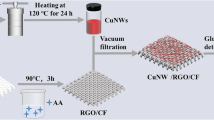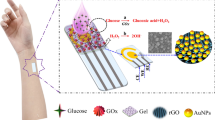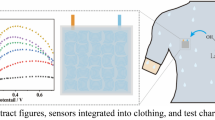Abstract
A strategy was proposed to modify cotton fabrics (CFs) by dipping-padding procedure using graphene oxide (GO) and aminofullerene (C60), and then the flexible reduced GO/fullerene fabric-based ion sensors (RGO/C60@CF) were prepared by chemical reduction method. Large amounts of zero-dimension of fullerene spheres were embedded in RGO sheets, and could exhibit different dipole–dipole interactions on various cations or anions with different sizes by virtue of their electron deficiency characteristics, which made RGO/C60@CF show different resistivity to different ions, thus endowing the modified fabrics with responsiveness to different ions. When the relative content of fullerene to graphene was 5%, the resistivity of the modified fabric (RGO/CF60@CF-5) was significantly different to different ions, i.e., the larger the ion radius, the greater the resistivity of the modified fabrics, and even if the ion concentration was only 1 mmol/L, RGO/C60@CF-5 exhibited good sensitivity. In addition, the fabric-based ion sensors also showed different sensing properties for different type of sweat, and their sensitivity only changed slightly after 1000 times of 180° bending. This work provides a basis for the design of the next generation of intelligent ion sensors with high sensitivity and flexibility.







Similar content being viewed by others
References
Atalay O, Atalay A, Gafford J, Walsh C (2018) A highly sensitive capacitive-based soft pressure sensor based on a conductive fabric and a microporous dielectric layer. Adv Mater Technol 3(1):1700237
Bhide A, Muthukumar S, Saini A, Prasad S (2018) Simultaneous lancet-free monitoring of alcohol and glucose from low-volumes of perspired human sweat. Sci Rep 8(1):6507–6507
Cai G, Yang M, Xu Z, Liu J, Tang B, Wang X (2017) Flexible and wearable strain sensing fabrics. Chem Eng J 325:396–403
Cao T et al (2018) Interfacial engineering via inserting functionalized water-soluble fullerene derivative interlayers for enhancing the performance of perovskite solar cells. J Mater Chem A 6(8):3435–3443
Cui L, Zhang P, Xiao Y, Liang Y, Liang H, Cheng Z, Qu L (2018) High rate production of clean water based on the combined photo-electro-thermal effect of graphene architecture. Adv Mater 30(22):1706805
Dang W, Manjakkal L, Navaraj WT, Lorenzelli L, Vinciguerra V, Dahiya RJB et al (2018) Stretchable wireless system for sweat pH monitoring. Biosens Bioelectron 107:192–202
Du D, Li P, Ouyang J (2016) Graphene coated nonwoven fabrics as wearable sensors. J Mater Chem C 4(15):3224–3230
Gao Y, Yu L, Yeo JC, Lim CT (2020) Flexible hybrid sensors for health monitoring: materials and mechanisms to render wearability. Adv Mater 32(15):1902133
Ge J et al (2016) A stretchable electronic fabric artificial skin with pressure-, lateral strain-, and flexion-sensitive properties. Adv Mater 28(4):722–728
Gorzalski AS, Donley C, Coronell O (2017) Elemental composition of membrane foulant layers using EDS, XPS, and RBS. J Membr Sci 522:31–44
Gu W, Yushin G (2014) Review of nanostructured carbon materials for electrochemical capacitor applications: advantages and limitations of activated carbon, carbide-derived carbon, zeolite-templated carbon, carbon aerogels, carbon nanotubes, onion-like carbon, and graphene. Wiley Interdiscip Rev Energy Environ 3(5):424–473
Huang T et al (2018) Phase-separation-induced PVDF/Graphene coating on fabrics toward flexible piezoelectric sensors. ACS Appl Mater Interfaces 10(36):30732–30740
Imani S, Bandodkar AJ, Mohan AMV, Kumar R, Yu S, Wang J, Mercier PP (2016) A wearable chemical–electrophysiological hybrid biosensing system for real-time health and fitness monitoring. Nature Commun 7(1):11650
Islam GMN, Ali A, Collie S (2020) Textile sensors for wearable applications: a comprehensive review. Cellulose 27(11):6103–6131
Kim SJ, Song W, Yi Y, Min BK, Mondal S, An K-S, Choi C-G (2018) High durability and waterproofing rGO/SWCNT-Fabric-Based multifunctional sensors for human-motion detection. ACS Appl Mater Interfaces 10(4):3921–3928
Kuang B et al (2018) Chemical reduction dependent dielectric properties and dielectric loss mechanism of reduced graphene oxide. Carbon 127:209–217
Li B, Xiao G, Liu F, Qiao Y, Li CM, Lu Z (2018) A flexible humidity sensor based on silk fabrics for human respiration monitoring. J Mater Chem C 6(16):4549–4554
Liu G (2019) Tuning the properties of charged polymers at the solid/liquid interface with ions. Langmuir 35(9):3232–3247
Liu L, Kou R, Liu G (2017) Ion specificities of artificial macromolecules. Soft Matter 13(1):68–80
Liu W et al (2020) Stable wearable strain sensors on textiles by direct laser writing of graphene. ACS Appl Nano Mater 3(1):283–293
Lo Nostro P, Ninham BWJCR (2012) Hofmeister phenomena: an update on ion specificity in biology. Chem Rev 112(4):2286–2322
Pederson MR, Quong AAJPRB (1992) Polarizabilities, charge states, and vibrational modes of isolated fullerene molecules. Phys Rev B 46(20):13584
Ren J, Wang C, Zhang X, Carey T, Chen K, Yin Y, Torrisi F (2017) Environmentally-friendly conductive cotton fabric as flexible strain sensor based on hot press reduced graphene oxide. Carbon 111:622–630
Sanaya BS, Victor VB, Miller DM, Frieboes HBJM (2018) A review of metabolism-associated biomarkers in lung cancer diagnosis and treatment. Metabolomics 14(6):81
Song M, Yu H, Zhu J, Ouyang Z, Abdalkarim SYH, Tam KC, Li Y (2020) Constructing stimuli-free self-healing, robust and ultrasensitive biocompatible hydrogel sensors with conductive cellulose nanocrystals. Chem Eng J 398:125547
Trung TQ, Le HS, Dang TML, Ju S, Park SY, Lee N-E (2018) Freestanding, fiber-based, wearable temperature sensor with tunable thermal index for healthcare monitoring. Adv Healthc Mater 7(12):1800074
Trung TQ, Lee N-E (2016) Flexible and stretchable physical sensor integrated platforms for wearable human-activity monitoringand personal healthcare. Adv Mater 28(22):4338–4372
Umeyama T et al (2017) Regioisomer effects of [70] fullerene mono-adduct acceptors in bulk heterojunction polymer solar cells. Chem Sci 8(1):181–188
Varadwaj PR, Varadwaj A, Marques HM (2019) C70 Fullerene cage as a novel catalyst for efficient proton transfer reactions between small molecules: a theoretical study. Sci Rep 9:10650
Wang C et al (2016) Carbonized silk fabric for ultrastretchable, highly sensitive, and wearable strain sensors. Adv Mater 28(31):6640–6648
Wang F, Jiang J, Sun F, Sun L, Wang T, Liu Y, Li M (2020) Flexible wearable graphene/alginate composite non-woven fabric temperature sensor with high sensitivity and anti-interference. Cellulose 27(4):2369–2380
Wang X, Liu Z, Zhang T (2017) Flexible sensing electronics for wearable/attachable health monitoring. Small 13(25):1602790
Yin B, Wen Y, Hong T, Xie Z, Yuan G, Ji Q, Jia H (2017) Highly stretchable, ultrasensitive, and wearable strain sensors based on facilely prepared reduced graphene oxide woven fabrics in an ethanol flame. ACS Appl Mater Interfaces 9(37):32054–32064
Yuan H, Liu G (2020) Ionic effects on synthetic polymers: from solutions to brushes and gels. Soft Matter 16(17):4087–4104
Zhang H et al (2019) Structure and electrocatalytic activity of flexible reduced graphene oxide/fullerene smart fiber. Carbon 142:411–419
Zhang Y, Batys P, O’Neal JT, Li F, Sammalkorpi M, Lutkenhaus JL (2018) Molecular origin of the glass transition in polyelectrolyte assemblies. ACS Cent Sci 4(5):638–644
Zhou Q, Yan B, Xing T, Chen G (2019) Fabrication of superhydrophobic caffeic acid/Fe@cotton fabric and its oil-water separation performance. Carbohydr Polym 203:1–9
Zhu D, You J, Zhao N, Xu H (2019) Magnesium regulates endothelial barrier functions through TRPM7, MagT1, and S1P1. Adv Sci (Weinh) Adv Sci 6(18):1901166–1901166
Acknowledgments
This work supported by the Natural Science Foundation of Zhejiang Province (LY21E030018), the Open Project Program of Key Laboratory of Yarn Materials Forming and Composite Processing Technology of Zhejiang Province (No. MTC-2020-12, MTC-2020-01, MTC-2020-25), and the National Training Programs of Innovation and Entrepreneurship for Undergraduates (202010354006).
Author information
Authors and Affiliations
Corresponding author
Ethics declarations
Conflict of interest
The authors declare that they have no conflict of interests.
Additional information
Publisher's Note
Springer Nature remains neutral with regard to jurisdictional claims in published maps and institutional affiliations.
Supplementary information
Rights and permissions
About this article
Cite this article
Zhang, J., Zhou, Q., Cao, J. et al. Flexible textile ion sensors based on reduced graphene oxide/fullerene and their potential applications of sweat characterization. Cellulose 28, 3123–3133 (2021). https://doi.org/10.1007/s10570-021-03730-z
Received:
Accepted:
Published:
Issue Date:
DOI: https://doi.org/10.1007/s10570-021-03730-z




